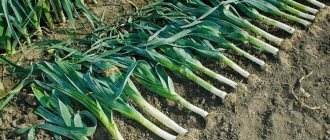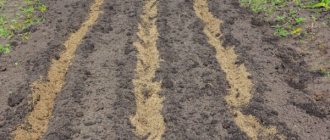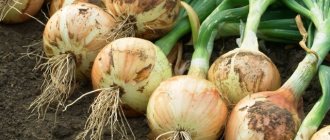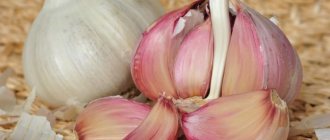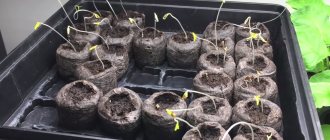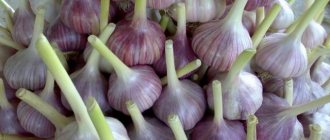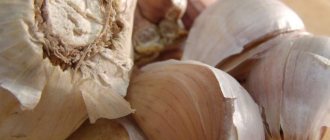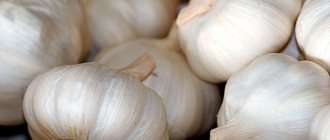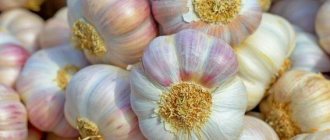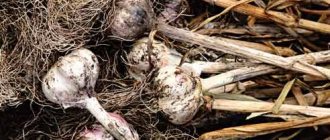The difference between the two types of garlic
Garlic planted in the fall is called winter garlic. It differs from those planted in spring in the structure of the head and the presence of inflorescences.
In the winter species, the head is supported on a central rod, around which denticles grow in a single row. The segments are large, usually from 6 to 10. In summer varieties, the head does not have a stem, small cloves form several rows.
In the inflorescences of winter garlic, by the time of harvesting, bulbs, the rudiments of new cloves, form. They are planted simultaneously with full-fledged segments in the fall, and the next year small single-toothed heads grow.
How to determine the maturity of winter garlic?
The most important thing is to determine when winter garlic needs to be harvested. There are several phases of maturation:
- The leaves turn yellow and then wither.
- The arrows straighten the “hook”, the tip of the inflorescence looks directly into the sky.
- The inflorescence opens, revealing pink bulbs.
- The neck of the stem becomes soft and breaks off when pulled out.
- The head breaks up into individual cloves.
Experienced gardeners advise harvesting garlic planted before winter when the second or third phase begins. Then the vegetable turns out to be overripe, making it difficult to harvest. Unripe garlic does not store well. If you wait until the fifth stage, most of the crop will be lost. Next year, of course, it will be found - with fresh shoots. They can be transplanted to another place.
On a note
: You should not leave arrows on every plant. The energy will be used to form bulbs, which will delay the correct formation of the heads. It is enough to leave 2-3 pieces for the entire plantation. They will become signal beacons, and at the same time provide seed material for renewing plantings in the future (in 2-3 years).
When to harvest garlic in 2021
In the southern regions of Belarus, winter garlic can be harvested in the first half of July, in dry, hot years - even at the end of June. In the rest of the country - after July 15. Spring garlic has a ripening period about a month later.
Fans of the lunar calendar usually carry out harvesting on the waning moon. In 2021, the second half of July will be marked by a waxing moon, since the new moon was on the 20th. Due to heavy and frequent rains in the second month of summer, the ripening of garlic slowed down. Therefore, you will have to act without fanaticism: wait until the arrow of the winter crop straightens its tip into the sky, and dig up the heads on the first dry day.
The waning moon in August will be from 4 to 18. Whether summer garlic will ripen during this period, we just have to wait. It is definitely worth excluding cleaning on the days of the full moon (August 3) and new moon (August 19).
Preparing and storing garlic
When harvesting a crop from the garden for storage, you need to properly prepare it. Drying lasts about 1.5 weeks. The procedure is simple. The collected product is laid out in a dry place, protected from rain. In arid regions, the heads are left directly on the garden bed. It is better to choose the space of a veranda, closed balcony, barn, etc. As soon as the fruits have dried, the tops and roots are cut off. Otherwise, germination will begin in winter. The spine should be 3-5 mm long. Pruning is done using garden shears or pruning shears.
Garlic is added to dishes, body and hair care products, used as a separate food and as a component of side dishes. To enjoy a tasty, fresh harvest full of nutrients, you need to properly preserve it after harvest.
How to properly dig up crops?
Since the heads of winter garlic sit in the ground at a depth of approximately 10-15 cm, you need to remove the garlic from the garden using a shovel or fork. It is most convenient to do this together: one digs up the plant, retreating about 10 cm from the stem, the other pulls it out of the ground. If you just pull on the tops, the stem may break off. Then the head will be found only when digging the ridge for the winter.
Summer garlic “sits” closer to the soil surface, but its stems are thin and already wilted. To clean it, a metal scoop 10 cm long is enough.
Any tool must be used carefully, as garlic cloves are very easy to cut.
When to collect garlic and what to do with it after digging it up
When summer is in full swing, many housewives begin to puzzle over when and how to properly harvest garlic so that it lasts all winter. After all, not only the shelf life of the vegetable, but also its taste depend on the correctness of this event.
How to understand: is a vegetable ripe?
By and large, garlic ripens quite evenly, so the signs of its “readiness” are easy to determine:
- the lower leaves of the plants turn noticeably yellow;
— the outer films dry out and acquire a color characteristic of a particular variety;
— the teeth are easily separated from each other on the bulb;
- arrows in shooting varieties, which were previously curled into a ring, are straightened;
— the integrity of the boxes with bulbs is compromised;
— the tops lie down and dry out.
All of these factors indicate the “technical” ripeness of the crop, that is, the formation of the underground part of the plant has not yet been completed - this will happen after harvesting. If there is visible cracking of the heads, you need to urgently dig up the garlic, as it can germinate again.
Note!
Leaving garlic in the garden for a long time can cause it to lose its shelf life. There is a high probability that the harvest will not live up to expectations regarding its taste and beneficial properties.
Harvesting time for winter garlic
Experienced gardeners know how undesirable and dangerous it is to miss the optimal time for harvesting. The fact is that even a few extra days spent in the ground can have a very negative impact on the quality of the bulbs. It doesn’t matter where you live, you need to know the optimal time to harvest garlic planted in the fall.
First of all, you need to selectively dig up a few bulbs and check them for ripeness.
If the vegetable meets all the criteria, you can safely begin the harvesting process. For most winter varieties of garlic, the period from July 20 to early August is considered favorable for digging. At the same time, you first need to make sure that massive lodging of the tops has occurred - this will signal when to harvest the garlic planted in the fall. Popular news Timing for harvesting spring garlic
Everything is more or less clear with winter varieties, but when to dig summer garlic remains an unresolved issue for many. As practice and reviews show, most summer residents harvest spring varieties about two weeks later after winter ones. You need to focus on mid-August - the first half of September. However, it is necessary to take into account the timing of planting the crop in the spring and the short growing season.
The timing can also be shifted in one direction or another due to weather conditions, the characteristics of the planted variety and the quality of care for the beds in the summer. That is why it is very important to carry out timely watering and fertilizing, because they are one of the decisive factors influencing the maturation of the bulbs.
Similar to winter varieties, the ripeness of spring garlic can also be easily determined by the condition of the leaves - the lower ones should be completely dry while the upper ones are just touching. In this case, the head of the plant still remains solid and does not crumble when lightly pressed on it.
Important!
Since spring varieties of garlic store much better than winter varieties, it is not recommended to skip the optimal harvest time.
Preparing garlic beds for harvesting
Last attempts to improve the quality of the crop can be made about two weeks before the recommended harvest time. At this time, the plant stops growing, and the heads are actively filling. The leafy part is tied in a knot or pressed down - this promotes the active outflow of nutrients into the turnip. Thus, the ripening of garlic increases by about 2 weeks, but this method only works in dry summers. In the case of the rainy season, it is extremely undesirable to use it, since a long stay in damp soil can cause the development of fungal diseases.
It is very important to bare the bulbs halfway from the ground as soon as the inflorescences straighten. The procedure is especially relevant in the case of damp soil, since this is how oxygen can penetrate to the teeth. Neglecting such a little trick will make it difficult for the plant to fully nourish itself, as a result of which it will begin to experience oxygen starvation and die. Raking, on the contrary, not only actively nourishes the garlic, but also allows it to ripen 3 to 5 days faster than usual.
How to harvest garlic correctly?
If you can already decide on the timing, then the procedure itself is questionable and causes concern. And this is probably correct, because if you do everything thoughtlessly, you risk wasting all the efforts spent earlier.
Of course, you can avoid troubles - you just need to know how to remove garlic and apply this knowledge in practice:
— Ripe garlic sprouts quickly, so you can’t hesitate to dig it up.
— It is not recommended to harvest after rain.
— You cannot pull the plant out of the ground by the tops, as this can injure the bulb. For these purposes you need to use a shovel or pitchfork.
— The dug up tubers must be dried in air for 5 - 6 hours, after which the crop must be hidden in the barn.
- In the latter, the garlic must be thoroughly dried directly with the tops for about 2 weeks, spreading the tubers in a thin layer.
— If possible, you can prefer a greenhouse for drying, which has ideal conditions for this. It is very important to turn the garlic over from time to time.
— You need to finish the drying process by removing the roots (you should leave about 3 mm) and the stem (the remainder is 10 cm from the bulb).
If there are plants with arrows in the beds, you need to wait another week and a half to dig them up. During this time, the flower stalks will begin to turn yellow, after which they can be cut and collected into a bunch. Drying of the “composition” should be carried out in the shade for 20 - 25 days - this is enough for the bulbs to fill well and acquire the “right” color for the variety. Such flower stalks must be stored separately from the rest of the harvest.
How to properly store garlic?
Before storing the garlic, it is necessary to thoroughly dry it.
Drying the crop
The collected heads are not immediately separated from the stems. First, the garlic is dried in the sun for a couple of hours, then removed from the garden into a room (ideally a well-ventilated attic) and laid out on newspapers, cardboard, or hay.
If it rains constantly and dry weather is not expected, after digging the heads and stems are carefully cleaned of soil and immediately laid out indoors. When the roots are dry, shake out the soil as much as possible.
In ordinary dachas, you can spread garlic on the floor of the room. On clear days, it is taken out into the open air and dried under the sun.
After a week or two, when the tops have completely dried out and the husks have become hard and rustling, pruning is carried out, forming a stump 5-10 cm long at the head. It is convenient to chop off the hard stem of winter garlic with a small hatchet. Dry leaves of summer garlic and the beard of roots (both types) are cut off with pruning shears. The length of the roots is left at 1 cm. After trimming, the garlic heads are placed in boxes up to 10 cm high made of plywood or plastic in 1 layer and dried for another couple of weeks.
Cleaning rules
Different types of garlic have their own assembly characteristics. Spring crops, which are considered summer crops, “give signals” before ripening begins. Yellowed foliage indicates readiness for harvesting. Usually its term is the second half of August. Winter is considered a winter species. Vegetables can be harvested as soon as you notice several signs:
- cracking of the surface of the inflorescences;
- yellowing of the lower leaves;
- drying of bulb scales.
The winter variety is harvested at the end of July. If the vegetable shows signs of ripeness, you need to start harvesting immediately. It should be carried out in dry and warm weather. It is not recommended to delay harvesting garlic. Late deadlines threaten to reduce the quality of the product. There is a risk that it will not be stored well.
An overripe crop is characterized by bursting scales and separation of the heads into cloves.
It is better not to leave a damaged onion for storage. It is recommended to harvest the crop using a pitchfork or shovel. Then the vegetable is laid out to dry. The heads and roots are shaken off of excess soil.
